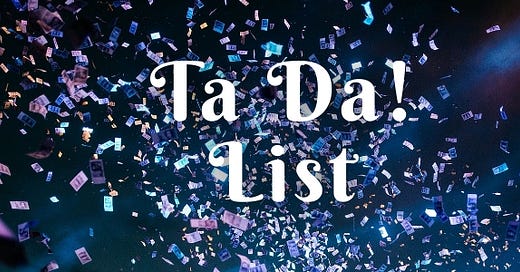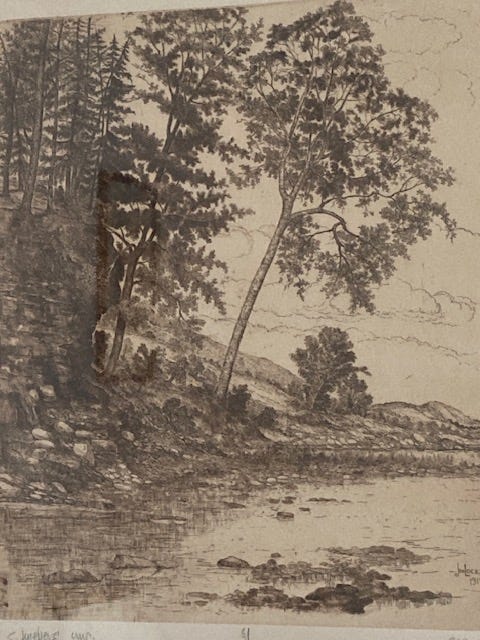Welcome, I’m Mary Louisa Locke, the author of the USA Today best-selling Victorian San Francisco Mystery series and the Caelestis Science Fiction series. In this daily newsletter, I reflect on my life as an indie author trying to age gracefully, including my struggles to maintain a balanced life, what I listen to, read, and watch for entertainment, and occasional bits of information I’ve gleaned from doing the research for my novels.
Daily Diary, Day 1195:
First of all, I want to thank those of you who read last week’s Ta da! post, it was one of my highest percentage openings I’ve had for anything but Historical Tidbit posts, which are always favorites. And I also wanted to thank the two people who became paid Patrons of this newsletter last month, which brings the total up to 12. As a reminder, everything I post will continue to be free for everyone, but those who upgrade to paid subscriber are helping me pay for some of the marketing, which frees me up to write more on in my fiction and in this newsletter.
Anyway, this week I am celebrating two things.
The first I already wrote about in Thursday’s post, so I won’t expand much on this. But I am really happy that I have finished doing the basic outline for the rest of the novel I am working on, In Ddaera’s Embrace, and I about to start writing this last third of the novel. I am over the 50,000 mark, the goal is 75,000 words for the first draft, and since I wrote 20,000 words in November, I can now at least hope that I could have that draft done sometime in January.
The second event I want to celebrate is that I have decided on the female occupation I am going to research for my next full-length historical mystery novel. See yesterday’s post on how this process worked for my first four novels—first the occupation, then the research, then the mystery plot.
Being an illustrator is the next occupation I plan on making the center of my next Victorian San Francisco mystery. An illustrator is defined as “an artist who makes illustrations,” and illustrations are defined as “something that illustrates, as a picture in a book or magazine.”1 Dictionary.com
With the invention of the printing press, illustrations that were engraved on wood blocks or etching in metal could be transformed into mass-produced pictures that could be sold independently or used to illustrate a wide variety to fiction and non-fiction in books, newspapers, magazines, hand-bills, etc. This practical art from reached a peak in the in the 19th century.2
My interest in the occupation of illustrators comes from two sources. The first is personal. My great, great grandfather, Joseph Locke, was a famous artist/illustrator who made his living etching glass, as well as inventing several different kinds of art glass, including Amberina, and Pomona glass ware. He also etched elaborate landscapes on copper plates, (see below) which could be then printed out and sold, although I think this was just a sideline.
The second source of my interest in illustrators as a female occupation came from doing the research for my fourth full-length novel, Deadly Proof. With the expansion of print for newspapers and books in the 19th century came a demand not only for women to work in the printing trade as typesetters, but there was also in increase demand for illustrators. In my research, I ran across two sisters, Mary and Leila Curtis, who lived in San Francisco and were rather well-known illustrators. While these particular women were not actively engaged in the engraving of illustrations in 1883, I remember noting to myself that this might be a good occupation to pursue further in a future novel.
The following is an excerpt from a piece about these sisters.
As teenagers, Leila Curtis and her sister Mary became fascinated with the process of copper engraving. Both parents, having a background in engraving, encouraged their daughters’ interest. Soon the sisters opened an engraving shop in the carriage house of their San Francisco home at 1117 Pine Street. Mary became the draughtsman, i.e., the artist, and Leila, the block-cutter. That endeavor led to a shop downtown and eventually a partnership called Crane and Curtis (1871). Mary withdrew from the business when she married Thomas Richardson in 1869. Her life’s work became painting; the Richardson house became a mecca for artists and writers. Mary Curtis Richardson became a well known, and very successful portraitist. When Leila married the New York portraitist Benoni Irving (1886), it was clear both sisters again, as in their early life, shared the rich, productive world of art. Another fascinating part of the Curtis history pertains, possibly, to mother Ceilia. A Celia Curtis, note the different name spelling, was one of the July, 1869 patriots who pioneered the California Woman’s Suffrage Association. Could it be that Ceilia and Celia were one and the same early suffragist in San Francisco?3
I eventually used what I learned about these sisters as a model for one of the very minor characters in Deadly Proof, Nellie Granger, and then for some reason I was prompted to reintroduce Nellie Granger in Lethal Remedies, as the daughter of a murder victim. I think I did this because I still had in the back of my mind that I wanted to look further into her occupation.
In addition, I have always been interested in reintroducing the artist Jeremy Voss from my first novel, Maids of Misfortune, into another story. I figure this means that both or either Nellie Granger and Jeremy Voss might turn to consulting Annie Fuller Dawson about some crime…whatever that crime may be, in this next book. But that decision is way down the road in my process.
Now that I have chosen illustrators as my next occupation to feature, I will start to accumulate sources of for my future research: books, articles, government reports, etc. Once the draft of In Ddaera’s Embrace goes out to beta readers, I will start to skim through those sources to get a better feel for the occupation. Once I have finished publishing In Ddaera’s Embrace, I will then concentrate even more on research, looking at newspapers and magazines of the period and trust that as I do this intensive research that a plot will come to me. I also expect as I go through this research stage, I will have some historical tidbit posts to share with you all.
If you enjoy my daily posts and would like to subscribe for free or become a patron (where you will get the pleasure of giving me the resources to spend more time writing and less time marketing) click the little button below. In addition, please do click on the heart so I know you’ve been to visit and/or share with your friends, and I always welcome comments! Thanks!
Dictionary.com
Illustration History, Norman Rockwell Museum https://www.illustrationhistory.org/history
Mae Silver, Women’s Cooperative Printing Union.






Your process is so interesting, and obviously very successful! You make the work of writing a good novel seem almost like a breeze (although I know it is not!).
Yay! Looking forward to both books!
It will be interesting to see what comes up about illustrators. I never would have thought of this as a viable occupation.